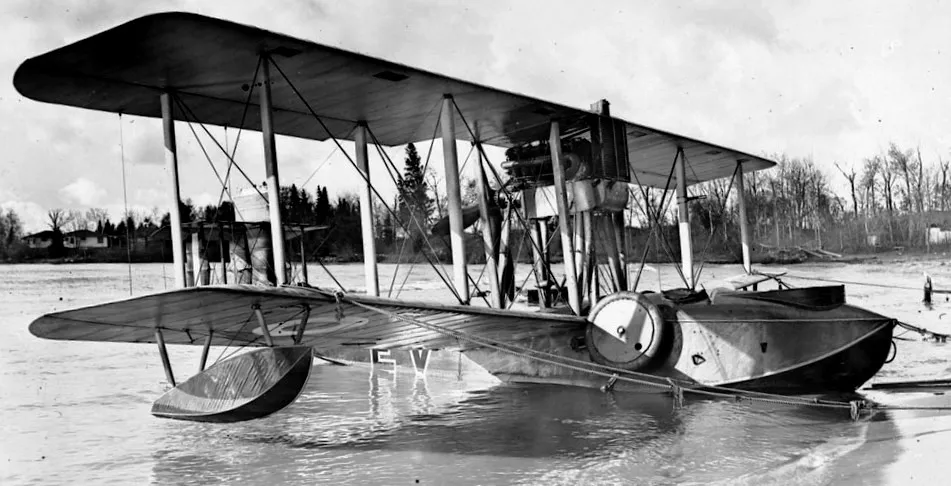Vickers Viking

Canadian Vickers Viking Mk. IV, RCAF Reg. No. G-CYEV, Victoria Beach, 1923
The Viking was a single-engine amphibious pusher biplane. Viking amphibians were built by Canadian Vickers Limited, a subsidiary company in Montreal, Quebec, with no previous aircraft manufacturing experience. Their involvement with the Viking led to a future line of indigenous flying boats beginning with the Canadian Vickers Vedette. Two Type 85 (Viking Mk. IV) delivered from Britain in 1923, followed by six aircraft built in Canada by Canadian Vickers at Montreal.
Canadian Vickers Viking Mk. IV (8), RCAF Reg. Nos. G-CYES, G-CYET, G-CYEU, G-CYEV, G-CYEW, G-CYEX, G-CYEY, G-CYEZ. Harold A Skaarup Web Page
A 7/8 scale replica is on display at the Alberta Aviation Museum.
 Vickers Viking IV at Alberta Aviation Museum
Vickers Viking IV at Alberta Aviation Museum
Viking G‑CYES
Weybridge
IV
Known Squadron Assignments:
Airframe shipped unflown from UK. RCAF supplied engines installed by Canadian Vickers. Used by No. 3 (Operations) Squadron at Rockcliffe and Shirleys Bay, Ont., 1925.last update: 2024-September-22
1923-June-15 Taken on Strength First flight, in Canada. 2020-09-19
1925-July-02 Struck off Strength Written off after crash. 2020-09-19
Viking G‑CYET
Weybridge
IV
Known Squadron Assignments: ;6
Airframe shipped unflown from UK. RCAF supplied engines installed by Canadian Vickers. Operated throughout Western Canada by No. 1 (Operations) Wing out of Winnipeg, Man. Surveyed northern Manitoba and Saskatchewan, including operations from Pelican River and Rabbit River, Sask., summer of 1924. Wheels removed for this operation, to reduce weight. Apparently was first aircraft to ever visit Prince Albert, Saskatchewan, during this mission. Returned to Victoria Beach on 14 August 1924, having covered 2,810 miles in 44:10 flying time. Broke an aileron control rod in flight over Manitoba on 4 September 1926. Crew made successful forced landing, and fabricated new rod from birch pole. Continued survey mission. Broke up after exiting cloud in steep dive, apparently had entered IFR conditions inadvertently.last update: 2024-September-22
1923-June-24 First Flight First flight, in Canada. 2019-08-20
1923-July-12 Taken on Strength 2022-02-07
1927-October-18 Struck off Strength 2022-02-07
 1927 KIFA RCAF Aircraftman 1st Class J T Eardley 2021-02-02
1927 KIFA RCAF Aircraftman 1st Class J T Eardley 2021-02-02 1927-July-11 KIFA RCAF Pilot Officer William Codington Weaver 2021-02-02
1927-July-11 KIFA RCAF Pilot Officer William Codington Weaver 2021-02-02Viking G‑CYEU
Montreal
Known Squadron Assignments:
First aircraft manufactured by Canadian Vickers. Used RAF surplus Eagle engines, received as part of the Imperial Gift. Christened at launching ceremony by Mrs. G.J. Desbarets, wife of the then Deputy Minister of Defense. Acceptance testing by J.L. Gordon and E.W. Stedman, would both become Air Marshalls in the next war. Based at Victoria Beach, Manitoba. With No. 4 Photo Detachment in summer of 1928, under command of Flying Officer (later A/M) Slemon. U/s with broken oil scavenger line at Big River, Saskatchewan in September of that year. later Tested to destruction at Winnipeg about 1931, following several hull failures on RCAF Vikings. The last survivng Viking, it had about 800 hours airframe time when withdrawn from use.last update: 2024-September-22
1923-July-24 Taken on Strength 2022-02-07
1923-July-25 First Flight Launching ceremony and first flight at Vickers Basin, Montreal. 2019-08-20
1931-May-04 Struck off Strength 2019-08-20
Viking G‑CYEV
Montreal
IV
Known Squadron Assignments:
Operated throughout Western Canada by No. 1 (Operations) Wing out of Winnipeg, Man. Also used at Cormorant Lake. Transported by road through Winnipeg on 19 September 1923, for winter storage in a rented garage.last update: 2024-September-22
1923-August-15 Taken on Strength 2020-09-19
1931-February-20 Struck off Strength 2019-08-20
Viking G‑CYEW
Montreal
IV
Known Squadron Assignments:
Used at Jericho Beach Air Station, probably from 1923. Noted as servicable at Vancouver, week ending 6 January 1924. Transferred to Victoria Beach, Manitoba (north of Winnipeg) in spring of 1925. Crashed there on 31 July 1926. Hull broke in two on takeoff, one of several such accidents with the Viking IV.last update: 2024-September-22
1923-August-31 Taken on Strength 2019-08-20
1926-October-15 Struck off Strength 2019-08-20
Viking G‑CYEX
Montreal
IV
Known Squadron Assignments:
Operated throughout Western Canada by No. 1 (Operations) Wing out of Winnipeg, Man. Seen at Victoria Beach, Manitoba, 28 May 1924. At Cormorant Lake Sub-Base in 1925.last update: 2024-September-22
1923-October-03 Taken on Strength 2019-08-20
1929-November-15 Struck off Strength Struck off, after Category A crash in Manitoba, on 25 August 1929. 2019-08-20
Viking G‑CYEY
Montreal
IV
Known Squadron Assignments:
Operated throughout Western Canada by No. 1 (Operations) Wing out of Victoria Beach, Winnipeg, Man.last update: 2024-September-22
1923-October-17 Taken on Strength 2019-08-20
1926-August-24 Struck off Strength Dug in a float on landing at Kashabowie Lake, Ont., hull broke in 2. Also reported as Struck off 22 July 1926. 2020-09-27
Viking G‑CYEZ
Montreal
IV
Known Squadron Assignments:
Operated throughout Western Canada by No. 1 (Operations) Wing out of Victoria Beach, Winnipeg, Man. Seen at Lac du Bonnet sub-base in 1927.last update: 2024-September-22
1923-November-09 Taken on Strength 2022-02-07
1930-August-28 Struck off Strength 2019-08-20
PC — Ctrl-F
Mac — ⌘-F
Mobile —


 Wikipedia Vickers Viking
Wikipedia Vickers Viking